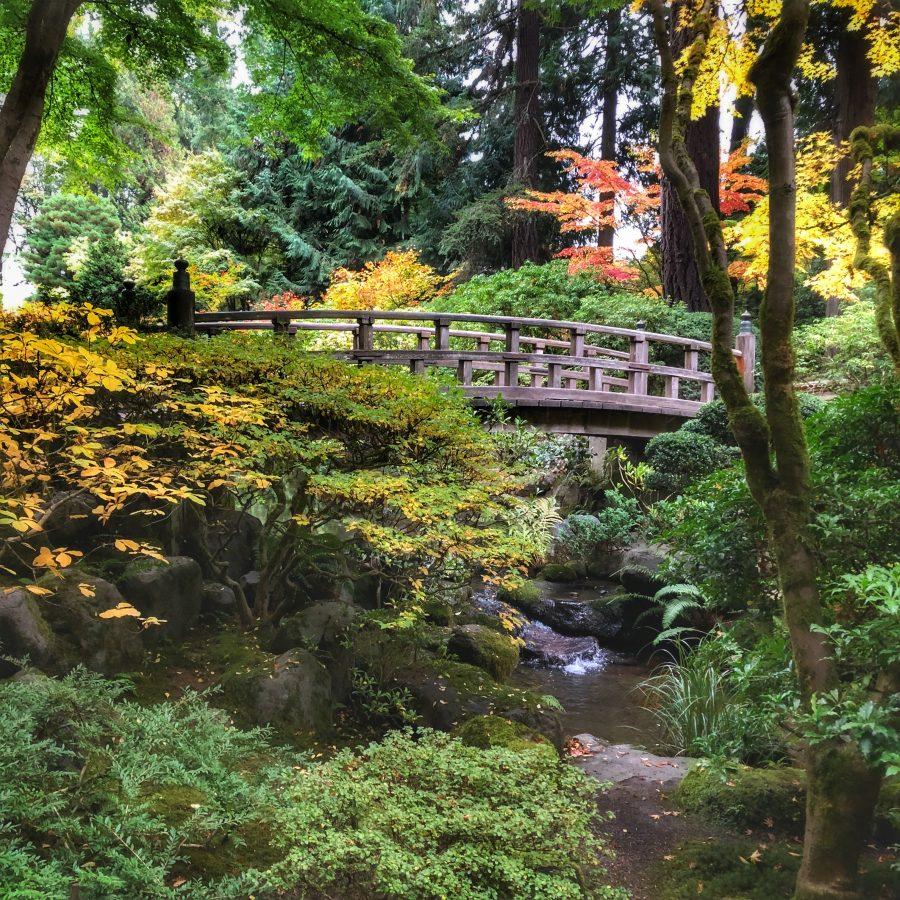Grow out of your comfort zone at the Portland Japanese Garden
Beautiful fall colors provide a wondrous and peaceful atmosphere within the garden.
The Japanese Garden has been a staple of the Portland community for over half a decade. Its tranquil scenery is an escape for many in the Portland-Metro area who lead a busy 9-5 lifestyle. Being described as the most “beautiful Japanese Garden outside of Japan” by Nobuo Matsunaga, a former Japanese Ambassador, encapsulates its authenticity. It’s a classic tourism spot, yet this onlooker appeal isn’t its only facet. The Portland Japanese Garden is not only a celebration of connected cultures and sister cities, but it honors both history and nature.
Oregon is considered the cultural parallel to Japan as it shares twenty-two sister cities with Japan, the most notable being Portland and Sapporo. This relationship between the country and Oregon dates back to the 19th century, when the Japanese first emigrated to Oregon for work. The Japanese Garden was built as a truce between Japan and Oregon following World War II after the mistreatment of the Japanese. With thriving cultural ties between the two, Oregon strived to create a safe place to bridge this sorrowful gap between the two nations.
Japan also finds itself intrigued with the Portland way of life. They are enthralled by the laid-back and carefree nature of Portland as it contrasted the grueling work ethic in Japan. To this day, there are over a dozen taprooms and stores inspired by Portland. There’s even a Portland-themed coffee shop selling Stumptown coffee.
Back in Portland, Japanese take a firm place in our food culture as well, with famous spots such as Marukin Ramen and Kizuki Ramen and Izakaya that started in Japan and found their way into Portland’s cuisine. Aside from the recreational shares between the two places, the famous cherry blossom trees along the Tom McCall Waterfront were a gift from the Japanese as well.
The Portland Japanese Garden was designed by Professor Takuma Tono of Tokyo Agricultural University in 1963. His purpose was to encompass the cultural and historical aspects of Japan and Oregon through five different garden designs that work together harmoniously. These five gardens include The Flat Ground Garden, The Strolling Pond Garden, The Tea Garden, the Natural Garden, and the Sand and Stone Garden. These gardens were opened to the public by 1980. In 2017 came the Cultural Village expansion of the Garden which included three new gardens to fully highlight the styles and impression of the Garden. These gardens included the Entry Garden, the Tsubo-niwa or the Courtyard Garden, and the Ellie M. Hill Bonsai Terrace. With the array and diversity of designs, the Portland Japanese Garden acquires over 350,000 visitors per year and this year, that includes me.
Portland’s free spirit meets the calm, orderly nature of Japan in this garden from the moment you step in. This time of year brought out the beautiful reds and oranges of fall embodying nature’s natural phenomena. While the leaves fell, the koi fish swam in a gorgeous pond adorned with small waterfalls. The crystal clear water brought out the vibrant colors of the Koi fish, which swam underneath my feet as I walked through the bridges. There are multiple buildings and architectural designs throughout, including bridges and wooden walkways above the water, aiding in the earthly tone and tranquility.
Experiencing the garden for the first time was an enlightening experience. It wasn’t just peaceful: it felt as if the world was still. People spoke in hushed tones, and everybody moved slower. It’s so often that we’re in a rush and always onto the next thing, never appreciating any one thing in the moment. While in this garden, I stopped and I appreciated every part. Although it only spans a few acres, it’s impossible to get through every scene in less than an hour.
Experiencing gardens such as this stress the influence of nature in our lives. The majority of the visitors of middle to elderly ages. This means that youth, like myself, rarely visit timely attractions such as the Japanese Garden. Teens are less likely to visit places like this. So often, teens are lost in social media, school, and their futures, when gardens like this are not eternal.
It’s important to experience these beautiful places before they disappear, not just for its aesthetic, but for the perspective. Our world is run by technology, and in-person experiences are often replaced with on-screen experiences that will never fully envisage the impact of our world. The world is too beautiful and too valuable to be left unseen.





!["About The Weather" was released in 2023 as the first album by Portland emo band, Mauve. [About The Weather Album Cover]](https://beavertonhummer.com/wp-content/uploads/2024/05/AboutTheWeather.jpg)



